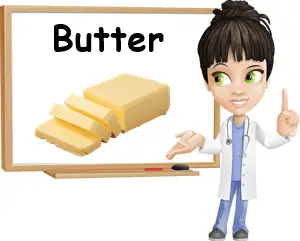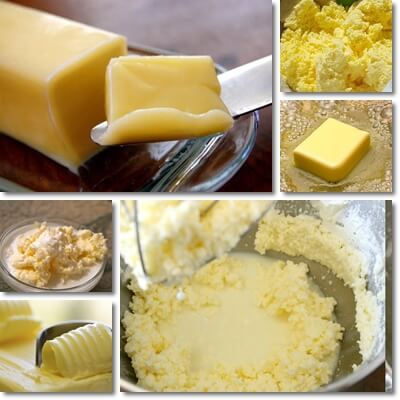Butter is a dairy product made from whole milk or cream. It consists of milk fat, usually 65% to 80%, between 30% and 15% water and around 5% milk proteins. It has virtually no carbs as it’s really just a solidified fat with a high content of not so healthy saturated fats. Despite this, it contains important amounts of healthy Omega-3 and Omega-6 fatty acids, conjugated linoleic acid and fat-soluble vitamins A and E. Despite its apparently second-rate nutritional profile, butter is actually quite a healthy dairy product and a source of several impressive health benefits. If intake is limited to small amounts, eating butter is good for skin, eyesight, fertility and digestion, feeds the brain and strengthens the immune system.
What is butter? Butter is mostly milk fat, also known as butterfat. It is primarily made from cow’s milk, although sheep, goat and the milk of other animals, including domesticated yaks and water buffaloes, can be used too. Butter is a dairy and contains fat from milk and, to a lesser extent, water and some protein. Its composition makes it a water-in-oil emulsion, meaning a mixture of two liquids that normally cannot undergo mixing (water and the fat from milk).

What is butter made from? Butter is made from whole milk or cream, either fresh (sweet) or cultured (soured, fermented – naturally or by addition of selected bacteria cultures following pasteurization). Depending on what it’s made from and how it’s made, butter can be classified into:
1) Sweet butter: produced from raw, sweet or fresh whole milk or cream (the layer of milkfat or butterfat that rises at the surface of raw, sweet or fresh whole milk). The milk may or may not be pasteurized, but usually is in commercial settings.
2) Cultured butter: produced from fermented whole milk or cream. On the one hand, there is the traditional cultured butter, made from whole milk or cream that fermented naturally thanks to the bacteria occurring naturally in the milk. On the other hand, there is the modern cultured butter, made from pasteurized whole milk or cream. Because pasteurization eliminates existing microorganisms in the milk or cream, selected bacteria cultured need to be reintroduced to produce fermentation (souring) and make the cultured butter.
Most commercial butter is made from pasteurized milk or cream. Pasteurization is required by food safety regulating agencies to prevent food-borne illness. However, despite being produced in limited amounts, a third type known as raw butter is also available.
3) Raw butter: made from unprocessed, unpasteurized whole milk or cream. May be cultured or sweet and usually has a short shelf life of about 1 week and a half in refrigerator conditions. It is made at home or by small producers, local farmers, usually as an artisanal dairy product.
4) Salted or unsalted butter. Depending on the country or region, the dairy product may be available in salted or unsalted versions.
5) Whey butter. Whey is the skim milky liquid that is left over after making cheese from milk. And it too can be used to make a type of butter called whey butter. Whey itself is a by-product in the dairy industry, yields very little cream as it’s low in fat and gives the butter a salty, cheese-like, sharp taste which is not very sough-after. For these reasons, whey butter is considered an inferior product.
What does butter look like?
Butter is a solid fat, usually light yellow in color or pale yellow. Depending on the diet of the cows or other animals providing the milk, color may range from white to a medium or deep yellow. Some producers may add natural or artificial food coloring to their butter, altering its natural color for commercial purposes. At room temperature, butter softens considerably and is extremely easy to spread on toast.
What does butter taste like?
Depends on what butter you’re eating. A good, home-made butter from grass-fed cow’s milk will have a light texture, soft consistency and taste rich, fatty, pleasant, with faint milk and other unique flavors. The flavor profile is given by the unique blend of fatty acids such as Omega-6 and Omega-3, methyl ketones, lactones, diacetyl and dimethyl sulfide. Commercial butter is more flavorless, unless from organic agriculture. The taste of butter is dependent on the properties and quality of the milk used which, in its turn, is dependent on the diet of the animals supplying the milk.

How to make butter at home
The simplest way to make butter at home is using cream. You can get sweet or sour cream (I prefer sweet cream), ideally with over 36% fat or, even better, 45% fat. Add it to a bowl and, using a hand mixer or stand mixer, mix it for several minutes until the milk fat (butterfat) separates and clumps together in a solid mass. The buttermilk, which is basically the leftover liquid in the cream, will remain on the bottom of the bowl. Once it’s done, you move the butter using a spoon in a clean bowl. You can add water to the bowl to clean the butter if needed. Know that the buttermilk is also edible. See Properties and Benefits of Buttermilk.
Butter nutrition and health benefits
If consumed in limited amounts, as part of an overall clean and balanced diet, butter is good for you, despite the high content of saturated fats (estimated at 50%). And it’s even better than margarine and other processed, vegetable oil spreads. It naturally provides generous amounts of vitamin A, small amounts of vitamin E, cholesterol and healthy Omega-3 fatty acids and other healthy fatty acids. Butter from grass-fed animals offers even better nutrition than commercial varieties.
How is butter good for you?
In small amounts. And the benefits of eating small amounts of it include:
1) Benefits for eyesight thanks to vitamin A.
2) Promotes healthy skin as a result of vitamins A and E and fat content.
3) Food for the brain thanks to fat content; helps reduce brain fog and mental fatigue.
4) Boosts immunity thanks to vitamin A and cholesterol.
5) Cholesterol protects nerve cells and helps synthesize vitamin D.
6) Good for fertility thanks to its high fat content and benefits of cholesterol on vitamin D metabolism and hormone production.
7) Contains Omega-3 fatty acids and conjugated linoleic acid with cardiovascular benefits.
8) Low in lactose – may be good to eat for those with mild lactose intolerance.
9) Cultured butter is a source of beneficial probiotic bacteria for better digestive health.
10) One of the least known butter benefits is that it helps relieve constipation naturally.
Butter side effects and potential health risks
1) High in fat and especially saturated fat. This is a problem only if you eat too much all the time. Excessive amounts of fat of all kinds can promote weight gain and affect cardiovascular health over time.
2) High in calories. Since it’s almost entirely a fat (80%), butter is naturally high in calories. Estimated energetic value is 717 kcal/100 g of butter (unsalted). One tablespoon of butter (14.2 g) has 102 kcal. Eating too much will ultimately lead to weight gain and increasing the risk for metabolic diseases like type 2 diabetes.
3) Allergy. Despite being low in milk proteins, butter still has some and is thus a source of allergic reactions for those with milk protein allergies. If you know or suspect you are allergic to proteins in milk, avoid eating milk and dairy such as cheese, yogurt, butter and all foods containing milk or dairy. When it comes to allergies, butter is bad for you even in the smallest amounts so make sure you avoid it.
4) Acid reflux and heartburn. Eating too much butter at once or by itself, plain, even in small amounts and especially eating butter before bed can trigger severe acid reflux and heartburn. Butter is best eaten during the day, with toast, rice, bagels or other absorbent foods and in limited amounts. See what foods to eat and to avoid for acid reflux.
5) Low smoke point. Butter is not the best choice for frying food because it has a low smoke point of only 150 degrees Celsius. The longer it’s heated to high temperatures, the more likely it is it produces harmful by-products with carcinogenic potential.
What is the best butter?
The best butter is the one containing 80% to 85% milk fat and is usually graded in most countries as type A or AA butter or class A butter or something similar. The more fat it contains, the higher its quality. In my opinion, the best butter is traditional or home-made butter, produced from whole milk or cream from organic agriculture. It usually contains less milk fat (around 65% – because the production process is carried out manually, using a churn or simple food mixer and is thus less efficient) and spoils fast (about a week and a half in refrigerator conditions).
However, the taste cannot be matched by any commercial product and it’s definitely free of additives like thickening agents or food dyes. And given that it’s from organic agriculture, meaning the cows have been grass-fed, a more natural diet suited to their nutritional requirements, you will be supporting humane treatment of animals and getting a particularly flavorful butter with a good nutritional composition, more exactly higher amounts of vitamins A, E and Omega-3.
